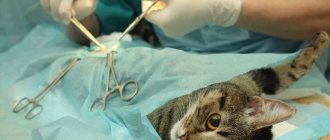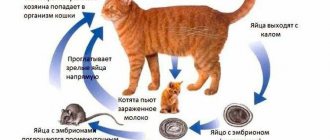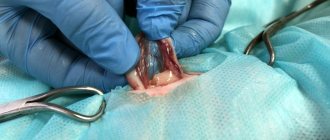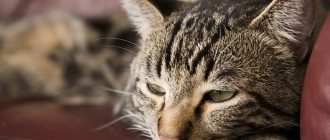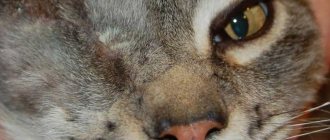Indications for the operation
Surgery is necessary in the following cases:
- When a narrowing (stricture) of the urethra forms after prolonged or frequently recurring urethritis.
- When the urethra is blocked by calculi (stones), sand or a neoplasm (malignant or benign).
- When the animal has weak bladder muscle tone.
- Due to perforation of the wall of the urethra during catheterization.
- If a previously performed stoma has closed and become impassable to urine.
In the overwhelming majority of cases, the reason for the operation is the formation of kidney stones, their removal through the urinary tract and their blocking by stones.
Factors influencing the development of the disease
Some people think that urolithiasis occurs only in neutered cats. But an operation to remove the testes can cause the appearance of urolithiasis only if it was performed too early and the organs of the excretory system remained underdeveloped.
Next, we will look at the main phenomena that contribute to the development of the disease.
Climatic and geochemical features - it turns out that high air temperature can also affect the frequency of urges. With an increased rate, primary urine is formed extremely rarely. Because of this, it is excreted in concentrated form. The composition of the water that the animal drinks every day and the soil also affects the pet’s body. Thus, exceeding the permissible level of lime salts leads to a decrease in the acidity of urine - stones are formed from accumulated crystals.
Features of the diet - the concentration of carbamide depends on how much protein your cat consumes. Excessive protein content in the diet when purine metabolism is disrupted leads to the occurrence of urolithiasis. In this case, it is necessary to reduce the protein content in the menu. The result of such a reasonable limitation will be a reduction in the amount of substrate that provokes the growth of pathogenic bacteria. At the same time, excesses can only aggravate the situation: a vegan diet for your cat or an abundance of dairy products is a direct path to alkaline urolithiasis.
A-vitaminosis - a lack of retinol provokes the development of urolithiasis. Make sure that your cat's diet contains special supplements or necessary plant products (butter, boiled or raw carrots). Often, A-vitaminosis can also occur in a cat that regularly replenishes retinol reserves. Poor functioning of the gastrointestinal tract is to blame - malabsorption and the inability of the liver to convert beta-carotene into retinol.
The following external factors can also lead to urolithiasis:
Hormonal imbalance - for example, excess parathyroid hormone can lead to increased calcium levels - not only in the blood, but also in the urine. And crystals of salts released from the bone tissue of the body are the building material for stones.
Features of anatomy - the urethral canal in cats is a curved tube that changes its position in front of the penis bone. It is at the point of the bend that the urine stops and is inhibited. When a pet is castrated early, the canal remains undeveloped, with a small diameter of the tube - and this is another reason for the formation of stones.
Pathologies of the digestive system - gastritis, colitis and other gastrointestinal diseases, which occur not only in bipeds, but also in their smaller brothers, lead to a violation of the ratio of acid and alkali in the animal's body. As a result, there is a decrease in calcium excretion in the urine.
Infectious diseases - infectious agents enter the urinary system in three ways: from the intestines and genitals, from the urethra or from distant sources.
In the latter case, stones and microorganisms are interconnected. Stones make it difficult to pass urine, creating a favorable environment for the development of microbes that provoke a new round of infection. And the latter, which has become chronic, promotes the accumulation of salt crystals and their binding into minerals of different shapes, sizes and consistencies.
Preparing for the intervention
Before the operation is performed, the cat is examined at the veterinary clinic. The sooner owners seek help, the less risk they have of losing their animal. Long-term disruption of the outflow of urine will negatively affect the general well-being of the cat and can lead to the development of acute renal failure.
The veterinarian will send his tailed patient for the following studies and tests:
- Ultrasound of the abdominal organs.
- Analysis of urine.
- Blood test (general and biochemistry).
- X-ray of the urinary tract using a contrast agent. Helps locate the location of the urethral blockage. It is performed again after the operation to determine its effectiveness.
If necessary, prior to surgical intervention, concomitant diseases are treated.
At what age do male cats get urolithiasis?
When diagnosing ICD, one of the main tasks is determining the type of stones. The choice of therapy largely depends on the composition of the uroliths. Veterinarians have compiled statistics regarding the presence of types of stones at different ages of predators.
Struvite is detected in animals from 2 to 7 years of age, and in females more often than in males. Siamese breeds are more at risk. Less commonly - Persian, Russian blue, Abyssinian.
Oxalate uroliths are more often found in animals aged 8-12 years. Struvite stones are usually detected in Persian, Himalayan, and Burmese breeds. Recurrence of oxalate uroliths is a potential problem.
Carrying out the procedure
After an ultrasound and x-ray, the doctor clearly knows where the stone is located, or the place of pathological narrowing of the urethra. The urethra is washed with an antiseptic solution, then a catheter is inserted. If the cat was not sterilized before the disease, then this procedure is performed before surgery.
If the animal's bladder is filled with stones and/or sand, it is opened and the contents are removed. If the intervention is not associated with the formation of stones, this stage is skipped.
An incision is made to allow the surgeon access to a wide area of the cat's urethra. After this, the genital organ is removed, the wide part of the urethra is brought out into the perineum or through the abdominal wall, and fixed to the skin.
Further care of the animal
At home, postoperative care for the pet is continued by the owners. Treatment of the wound with medications prescribed by the doctor is carried out daily for 14 days. To prevent the cat from unwinding the bandage and starting to lick the seams, he is given a collar of a suitable size. At first, until urination improves, it is recommended to use cat diapers (or baby diapers, if you make a cut on them for the tail).
Owners need to monitor the condition of the pet. If his health does not improve, the cat still cannot go to the toilet on his own, becomes weaker, refuses food and water, then the veterinarian should be informed about this. The appearance of purulent discharge from the wound, bleeding, and an increase in temperature are alarming signs that require immediate medical attention.
Postoperative care:
- In order to prevent the animal from tearing the stitches, a plastic collar is put on the neck until the surgical wound is completely healed. Also during this period, the cat is put on disposable diapers with a special cross-shaped cut for the tail (you can use regular diapers for children, in which a hole for the tail is cut with scissors). They are changed every 6-8 hours and after defecation. The stoma is treated with an antiseptic every time.
- To alleviate the condition, a urinary catheter is inserted for 3-4 days.
- After urethrostomy, a cat remains in hospital for 1-2 days. At this time, he is given intravenous electrolyte solutions, painkillers and other drugs (as indicated). Antibiotics are administered over 5-7 days.
- Local treatment includes washing the sutures and stoma with chlorhexidine and applying antimicrobial ointments.
We invite you to read: Castration of a cryptorchid cat, features of the condition of the operation and care
Consequences
After surgery, the newly created urethra may become infected, so it is very important to maintain hygiene and antiseptics. If the cat tries to lick or tear the stitches, he is put on an “Elizabethan collar.”
Sometimes a discharge containing blood may appear from the new hole, but this is within normal limits.
Usually, after the procedure, the animal recovers quite quickly: in about 15–30 days. Urinary incontinence sometimes occurs, but this is a rare complication.
If the hole is noticed to be overgrown, it is carefully bougieered. If it does not help, a repeat operation is performed.
Urethrostomy: early and late complications and cat care at home
Bleeding. To minimize postoperative bleeding, the corpus cavernosum of the penis is included in the urethral sutures. The bleeding is stopped by pressing on the spot. As a rule, bleeding does not pose a threat to the animal's life and does not require further surgery. If the bleeding is serious and constant, then under anesthesia the site of hemorrhage is identified and it is ligated or cauterized with a bipolar coagulator.
Acute renal failure. Its development can be facilitated by enlarged kidneys before surgery or when the cat is in a state of dehydration and hypotension for a sufficiently long time. A urine test needs to be done. If the specific gravity of urine is more than 1.030, then this suggests prerenal causes of renal failure. Appropriate treatment should be provided to correct dehydration, hypotension and hypovolemia.
Recurrent cystitis. It is often asymptomatic, so it is necessary to do a urine test every six months.
Stricture. It can occur if dirt gets into the seam.
Caring for your cat at home after surgery involves following all the veterinarian’s recommendations. Antibacterial therapy is usually prescribed for 6-7 days, antihemorrhagic drugs for 2-3 days, B vitamins
Externally, in the first days, you need to moisturize the thick part of the urethra, which is embroidered outward, with the help of petroleum jelly, wipe the seams with chlorhexedine bigluconate 0.05% and apply a thin layer of Levomekol ointment. All treatments must be carried out 2 times a day for two weeks. Throughout the healing period, the animal must wear a collar to prevent licking and scratching of the area of interest. Monitoring in the clinic is mandatory after the operation every other day (if there was no hospital) and then on the recommendation of the doctor.
The healing process is accompanied by severe swelling, and the damaged tissue can heal, thereby closing the urethral fistula. Therefore, it is advisable that the cat spend the beginning of the rehabilitation period under the supervision of veterinarians.
At home, postoperative care for the pet is continued by the owners. Treatment of the wound with medications prescribed by the doctor is carried out daily for 14 days. To prevent the cat from unwinding the bandage and starting to lick the seams, he is given a collar of a suitable size. At first, until urination improves, it is recommended to use cat diapers (or baby diapers, if you make a cut on them for the tail).
What is urethrostomy?
Obstruction (blockage) of the urethra is detected in many domestic cats. As a rule, at the first manifestations of this pathological condition, a diagnosis of “urolithiasis” is made. This problem does not arise only against the background of this disease. A plug in the urethra is formed from sand, salts, small stones and mucus.
Stones formed in the organs of the genitourinary system have different chemical compositions. Their number can vary from one to several hundred. The size of the stones can also vary. These domestic animals most often have struvite (tripelphosphates), less often - oxalates and urates.
When clogged, the bladder gradually stretches, which disrupts the integrity of the blood vessels and allows blood to leak into the urine and vice versa. The result of this is poisoning of the body. High pressure in the bladder travels up the ureters to the kidneys. Due to their tension, numerous hemorrhages occur.
Blockage of the urethra leads to kidney dysfunction and provokes a decrease in blood flow and filtration level in this organ. Urinary retention increases the amount of nitrogenous metabolic products in the blood, which are excreted by the kidneys. Subsequently, against the background of obstruction, severe poisoning of the body occurs. In some cases, the bladder may rupture.
In females, this phenomenon occurs as often as in males, but in most cases it does not have such pronounced manifestations. This is due to the special anatomical structure inherent in cats. Their urethra is 2 times shorter and wider than that of cats. For this reason, sand and small stones are easily released naturally through urine. In males, this organ is longer and narrower with 3 constrictions. This is what explains its frequent blockages.
Urethrostomy is designed to eliminate such disorders. During the operation, a new opening for urination (stoma) is formed in the animal. It is made between the peritoneum and the wide part of the urethra. The surgically created urethral opening is straight, wide and short. These sizes are sufficient for the free passage of sand and small stones.
Surgical intervention can be pre pubic or perineal. The first type is usually used to correct pathological conditions in the pelvic area. This procedure is resorted to only in cases of extreme necessity, when perineal urethrostomy is impossible for some reason.
Why is it dangerous?
If your cat has a large blockage, then as a result, his bladder begins to stretch. As a result of its stretching, all the blood vessels on the walls of the bladder burst. In this case, the blood further enters the animal’s urine. Or vice versa: urine into blood. Due to this, the body is poisoned by various residual chemicals in the urine that should have left it.
As a result of the above processes, the pressure in the bladder increases. It spreads higher to the kidneys, affecting them so that they become tense and then hemorrhages occur. Obstruction greatly disrupts the normal functioning of the kidneys, reduces the level of blood circulation in them and negatively affects filtration processes. Urinary retention in the body leads to the development of azotemia. This is a pathology that consists of an elevated level of nitrogenous substances in the blood.
shutterstock
Through this pathology, uremia develops further. This is self-poisoning of the body, which occurs due to severe impairment of kidney function. If timely surgery is not performed on a cat with urolithiasis, the bladder may rupture.
Symptoms
If you notice a decrease in your cat’s temperature after urethrostomy, he categorically refuses to eat, his muscles twitch, then this could be either uremia or azotemia. In this case, you should immediately seek help from a veterinarian!
After 10-14 days, when the urethrostomy was performed, and when the cat was fully restored after the urethrostomy, the sutures are removed. But this is done only after the clinic worker is completely convinced that they have healed and there is no inflammation on them.
They also pay special attention to whether the newly formed stoma is functioning normally. Animals who have undergone urethrostomy need to be examined and tested every six months.
Contraindications and possible complications after surgery
The operation is dangerous to perform in case of increasing uremic syndrome, hypertension, hypotension, and blood clotting disorders. However, if the urethra is completely blocked and catheterization is impossible, the operation is performed even in the presence of such contraindications, since the cat’s life depends on it. Doctors first give the animal medications to stabilize the condition, and after creating a stoma and removing the patient from anesthesia, they take measures to eliminate the risks of complications.
The most common complication of the operation is bleeding and swelling at the sites of tissue incision. Eliminated with the help of hemostatic agents and dressings. It is possible for a bacterial infection to develop in a surgical wound, so a course of antibiotics during the recovery period is mandatory. In rare cases, urinary incontinence develops due to impaired smooth muscle function. As a rule, after 5–10 days this complication goes away on its own. Much more dangerous is the overgrowing of the stoma with scar tissue - this threatens relapses with urinary retention, so a repeat operation is performed.
After treatment
When a little time passes after urethrostomy in a cat, the formed urethra may suddenly begin to narrow, that is, the processes of overgrowth begin. Here you will need to do a urethrostomy again. The fact that the urethra begins to overgrow may be a consequence of the operation itself being performed incorrectly by veterinarians, or it could be torn somewhere due to certain injuries. This complication is rightfully considered the most serious and severe.
Another complication that urethrostomy brings is often dysuria. In general, this disease disrupts the cat’s urination process. The underlying cause here may be the presence of certain bacteria in the urine after urethrostomy. Or it may be due to the costs of urological syndrome. Another reason leading to this complication is stones or a tumor located in the bladder. As already mentioned, urethrostomy does not cure urolithiasis, but only removes blockages.
